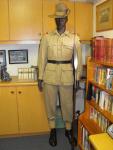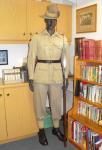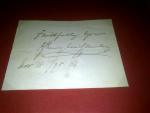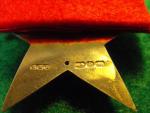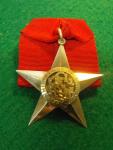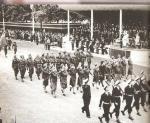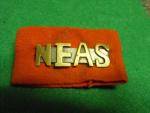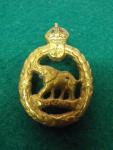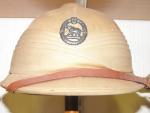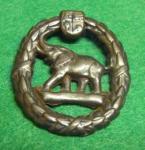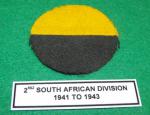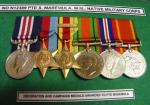
sabrigade
For Deletion-
Posts
1,707 -
Joined
-
Last visited
-
Days Won
34
Content Type
Profiles
Forums
Blogs
Gallery
Events
Store
Everything posted by sabrigade
-
As part of the annual gathering at the SA National Museum of Military History, which is scheduled on 30 and 31 July 2011, I intend displaying Private Masemula's Military Medal and other Native Military Corps related militaria. This is the mannequin that I have prepared. I will post photographs after the display. Regards, Will
-
The Royal Geographical Society ordered between approximately 200 of the stars from Carrington and Son of Birmingham for the princely sum of 7 shillings each. They are believed to have been manufactured by H. Jenkins. The stars are manufactured from sterling silver and are hallmarked "Birmingham 1889-90". 175 Stars were sent to McKenzie and Company in East Africa for distribution to the intended recipients and very few of these stars can be expected to have survived over the years. Nine of the stars were engraved with the recipient's name on the reverse. Three stars are in the RGS museum and 2 unnamed stars were personally given to Stanley. This specific example could possibly be one of the Stars owned by Stanley and it is accompanied by a personalized note/message from him. The expedition suffered very high losses and of the 60 Sudanese members of the expedition, 38 died, 2 were executed and 1 deserted. Only 19 Sudanese are therefore known to have survived the expedition. 12 Somalis and 675 Zanzabaris also took part. Of these members, 11 of the Somalis died or were killed. The Zanzibaris had 257 of their number killed/died, 2 were executed and 191 deserted. Therefore, 1 Somali and 225 Zanzibaris are known to have survived and completed the expedition. It is very apparent that the attrition rate of the expedition was extremely high. This is a therefore a very rare and exceptional award.
-
I am not sure if this post is in the correct place, if not, I am sure our capable moderators will place it where it shoud be. THE EMIN RELIEF EXPEDITION Formed under the auspices of the Royal Geographical Society, the expedition was sent to Africa by the Royal Geographical Society. The purpose of the expedition was to rescue Emin Bey and his followers after the Sudan had been abandoned to the Mahdi after 1884/5. Emin Pasha was the Governor of the Equatorial Province of the Sudan. The expedition trans versed Central Africa from the West to East coast and suffered innumerable hardships and dangers. Of the 748 African participants, only 245 are known to have survived. The expedition lasted nearly two years. The expedition was led by the interpid explorer, Henry Morton Stanley.
-
MASEMULA CITATION "Pte Masemula was captured with Pte H. Tshaka No 10718, 1 S.A.P. at Tobruk on 21.6.42 and after being kept in EL ADEM for a week, they were taken back toTobruk and made to work. During air raids they noticed that the Italian guards fled to their trenches, so on 22.7.42, during an air raid, they slipped through the wire and escaped. This, in spite of the fact that 4 Basutos had been brought back two days earlier, having escaped and been at large for 5 days, who told them of the hardships and difficulties they had experienced. They left the camp with two water bottles and a 2-gallon tin not quite full of water and a few biscuits. They went South towards EL ADEM and then East to the frontier and British Lines.They walked by night and slept by day. When they were lucky they found water and food in abandoned vehicles: otherwise they went short. They reached the Qattara depression. They went down into it and continued eastwards.When they came up they were exhausted. They decided to risk going north to the coast in order to find water and, as they hoped, our forces. On 18.8.42 they eventually reached our lines. These natives of whom Pte Tshaka was in-particular fairly intelligent and able to give information about conditions in TOBRUK performed a remarkable feat in walking about 300 miles across the desert , knowing nothing of the route, in an area controlled by the enemy and with the only hope of chance supplies of foods. The temptation to end it all by surrender must have been very great, but through dogged courage these natives eventually won through. A very fine performance." CITATION FOR THE IMMEDIATE AWARD OF THE MILITARY MEDAL: 23 SEPTEMBER 1942 AWARD GAZETTED: SUPPLEMENT TO THE LONDON GAZETTE: 20NOVEMBER 1942
-
THESOUTH AFRICAN VICTORY PARADE CONTINGENT To celebrate the British and Commonwealth victory over the Axis Powers, a contingent was formed to attend the parade and festivities in London. The Contingent was commanded by Major-General Evered Poole, CB, CBE, DSO, and former GOC of the 6TH South African Armoured Division who had led his division with distinction during the Italian campaign as part of the American 5th Army. The Contingent consisted of 222 men and 19 women and represented all the services and corps of the Union Defence Force. Private Masemula was one of the 9 decorated members of the Non-European Army Contingent that were selected to participate as official members of the Contingent. He was duly re-attested for the Contingent in Durban on 19 April 1946. The Contingent left Durban on 27 April 1946 and arrived in London on 24 May 1946. The NMC carried their issue spears on parade. After attending the festivities and after marching in the Victory Parade on 8 June, the Contingent returned to South Africa and landed in Durban on 6 July 1946. Masemula was discharged on 7 July 1946 at the age of 29. On his Discharge Certificate, Masemula was described as being "SLIM "of build, 6 Foot and 1 inch tall and his conduct was rated as"GOOD" during his service with the Contingent.
-
ORANGE-REDSHOULDER FLASHES AND NEAS SHOULDER TITLE WORN BY SOUTH AFRICAN FORCES DURING WW2 ORIGINALLYFOR VOLUNTEERS WHO SERVED ANYWHERE IN AFRICA. EXPANSION FOR THE OATH OF SERVICE TOOK PLACE IN 1943 AT THE CONCLUSION OF THE NORTH AFRICAN CAMPAIGN. THE "TAB" THEN INDICATED VOLUNTARY SERVICE IN ANY ALLIED WW2 THEATER. SIGNATORIES TO THE OATH LATER QUALIFED FOR THE AFRICA SERVICE MEDA.L


